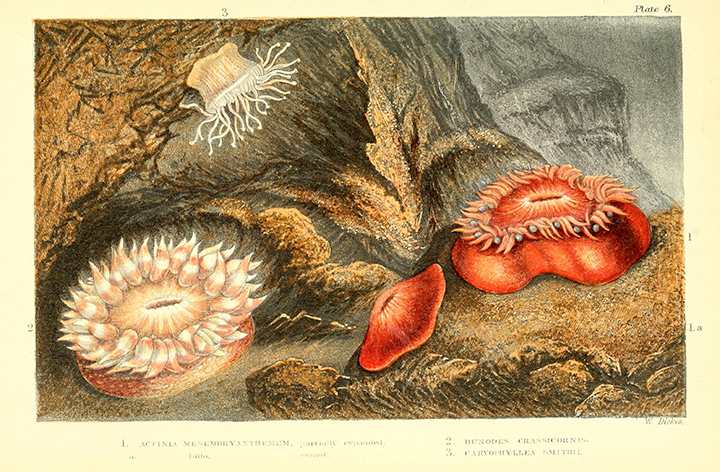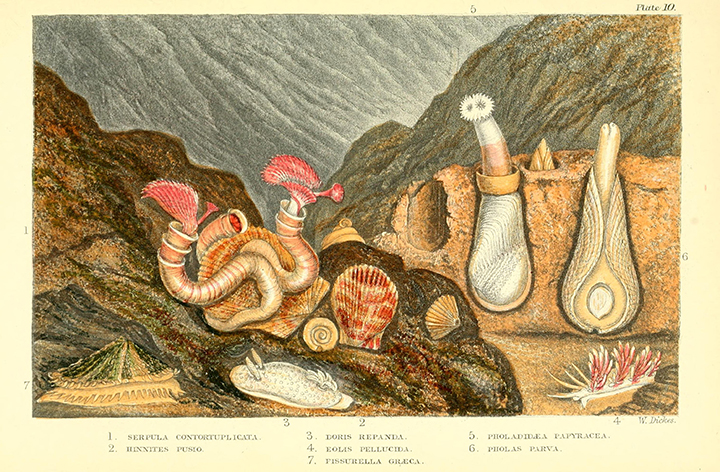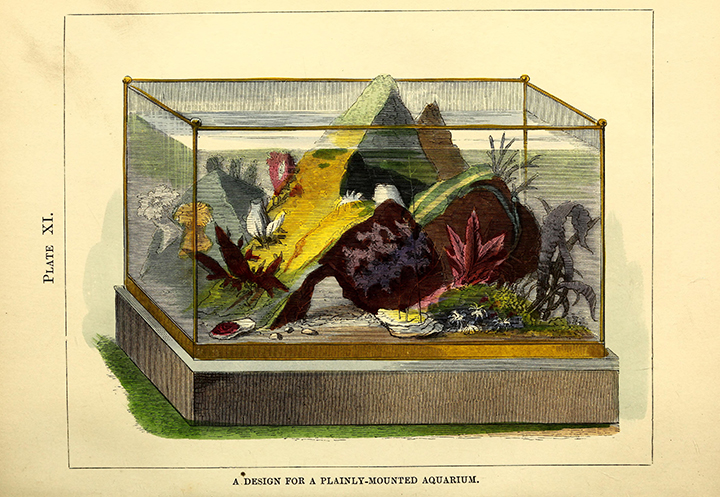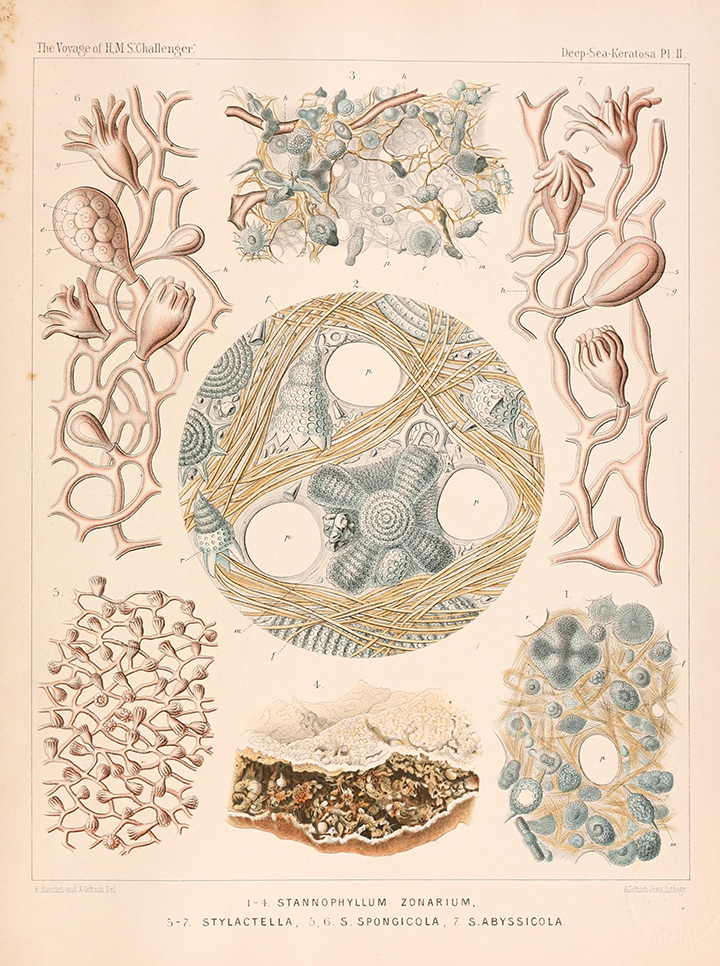Fantastic Worlds: Exploring the Ocean through Science and Fiction
In July 2015, BHL founding institution Smithsonian Libraries opened a new exhibit at the Smithsonian’s National Museum of American History entitled Fantastic Worlds: Science and Fiction 1780-1910. The exhibit invites visitors to explore the fantastic worlds of fiction inspired by 19th century scientific discovery and invention. It features fabulous natural history books on topics ranging from marine life to geology and dinosaurs and expeditions to the polar regions and interior Africa. Exhibit curators Kirsten van der Veen (Special Collections, Dibner Library, Smithsonian Libraries) and Doug Dunlop (Metadata Librarian, Smithsonian Libraries) not only walk visitors through some of the remarkable scientific discoveries of the Victorian era but also demonstrate the profound impact these advances had on popular fiction.
 |
| Kingsley, Charles. Glaucus. 4th Ed. (1859). http://biodiversitylibrary.org/page/29363521. |
In the exhibit section entitled “Sea Change: Underwater Worlds,” visitors can experience 19th century ocean exploration through the lens of publications, both scientific and fictional, produced during the time period. As the exhibit articulates:
“The sea was a vital part of 19th-century life: distant travel, commerce, and the livelihoods of many depended on it. Tales of sea voyages, both fact and fiction, were immensely popular. As scientists explored the depths of the oceans, however, stories began to take place not just on the sea, but in it.
In the early 1800s, scientists believed the deep sea simply could not sustain life. Knowledge of the oceans had largely been limited to shores and shallow waters, but the mid-19th century saw the start of our exploration of this immense underwater world. Technological improvements to submersible vessels and diving gear helped make the seas more accessible. The bold plan to lay a telegraph cable across the Atlantic Ocean made understanding the ocean floor essential, and helped drive deep-sea exploration further.
Victorian Britain had a fascination with the sea, and with the natural world in general. The pastime of shell collecting became very popular in the mid-1800s. As the middle class grew and people found themselves with leisure time, the seaside became a frequent holiday destination. Amateur naturalists and vacationers scoured the shores for specimens to add to their collections. Collecting and cataloging one’s findings was considered a morally appropriate, enriching activity, and a worthy antidote to idleness. This fascination mirrored the interests of the scientific community, as newly coordinated efforts to dredge for marine fauna and survey the coasts were initiated, to address the notable lack of new knowledge of the undersea world.
 |
| Kingsley, Charles. Glaucus. 4th Ed. (1859). http://biodiversitylibrary.org/page/29363529. |
Books on the identification of sea life, like Rev. Charles Kingsley’s Glaucus, or, The Wonders of the Shore, were very popular. Perhaps best known for his children’s book The Water Babies, Kingsley was a prolific writer of non-fictional works as well, including sermons, social commentaries, and scientific treatises. He was a capable amateur naturalist, too, well-versed in the scientific issues of the day (he and Charles Darwin corresponded) and a proponent of science education. Glaucus, named for an ancient Greek sea-god, encouraged personal and religious improvement through knowledge of the natural world, in this case the corals, mollusks, and anemones found at the seashore.
Interest in sea life found its way into the home in the 1850s as the first aquariums (or “aqua-vivariums”) appeared. Having a miniaturized version of the ocean floor at home became a mid-19th century fad. The first public aquarium opened in 1853 in London. Purveyors of aquatic plants and animals catered to aquarium enthusiasts. Books [such as Henry Noel Humphreys’ Ocean Gardens: The History of the Marine Aquarium. London, 1857] offered advice to enthusiasts on creating and maintaining their indoor “ocean gardens.”
 |
| Humphreys, Henry Noel. Ocean gardens : the history of the marine aquarium, and the best methods now adopted for its establishment and preservation (1857). http://biodiversitylibrary.org/page/43084496. |
As the exhibit shows, the public’s growing interest in the deep ocean can be clearly seen in the popularity of many of the fictional works of the time, especially Vingt Mille Lieues Sous les Mers (Twenty Thousand Leagues Under the Seas in English) by Jules Verne. Within the work, the famous Captain Nemo takes his captive guests on a journey through the oceans in his submarine. The work draws on many of the scientific advances, such as self-propelled submarines and diving suits, and features many of the exotic underwater species, that were captivating the public during the era.
Not only were the inventions and species featured in works like Twenty Thousand Leagues Under the Seas a reflection of the advances of the time, but the very idea of extended underwater expeditions like that undertaken by Captain Nemo also mirrored the scientific endeavors being launched. According to the exhibit:
“Britain’s Challenger expedition, a massive four-year undertaking begun in 1872, vastly increased knowledge about the deep sea. Its goal: to circumnavigate the globe and study the ocean’s depths. It was the first large-scale government-funded scientific expedition. The HMS Challenger was a British naval warship outfitted for scientific study and included a chemistry lab and a workroom for the study of specimens.
The expedition resulted in 50 volumes of scientific reports. More than 4,500 new species of marine life were recorded, and scientists were finally able to prove that life did indeed exist in the ocean’s depths. The hundreds of crates of specimens were painstakingly studied and illustrated by experts worldwide, like those by Ernst Haeckel [Report on the Scientific Results of the Voyage of H.M.S. Challenger during the years 1873–76…Zoology: Report on the Deep-Sea Keratosa. Edinburgh, 1889], and formed the basis for the marine collections at the Natural History Museum in London.”
 |
| Haeckel, Ernst. Report on the scientific results of the voyage of H.M.S. Challenger during the years 1873-76. Zoology v. 32, pt. 82 (1889). http://biodiversitylibrary.org/page/2225158. |
Many of the books featured in the “Sea Change: Underwater Worlds” section of the exhibit, such as Glaucus, Ocean Gardens, and Report on the Scientific Results of the Voyage of H.M.S. Challenger during the years 1873–76, can be found in BHL. You can learn more about underwater science and fiction in the Victorian period in the Fantastic Worlds online exhibit from Smithsonian Libraries. The exhibit at the Smithsonian National Museum of American History runs through February 26, 2017, and is free to the public. Be sure to visit the exhibit if you’re in Washington, D.C., or browse the online exhibit to learn more about the fantastic intersection of science and fiction in the Victorian era.
Exhibit Text Featured in this Post by:
Kirsten van der Veen
Special Collections, Dibner Library of the History of Science and Technology, Smithsonian Libraries





Leave a Comment